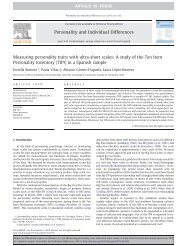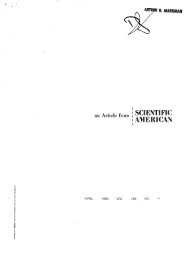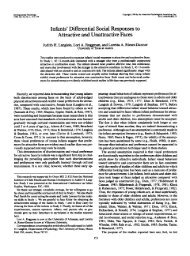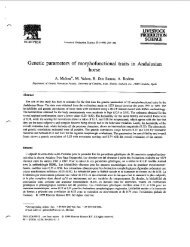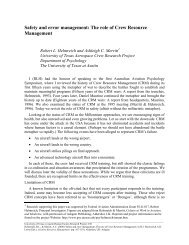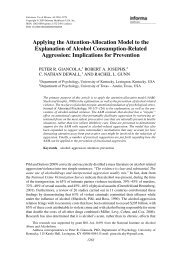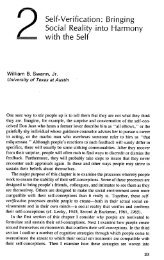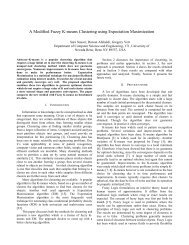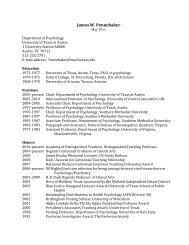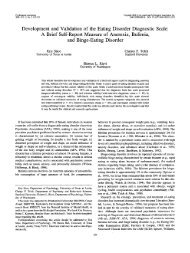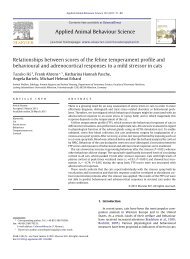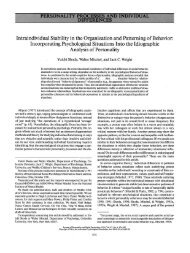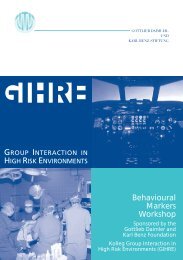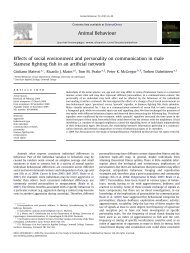The Word-Length Effect and Disyllabic Words (Lovatt
The Word-Length Effect and Disyllabic Words (Lovatt
The Word-Length Effect and Disyllabic Words (Lovatt
You also want an ePaper? Increase the reach of your titles
YUMPU automatically turns print PDFs into web optimized ePapers that Google loves.
THE QUARTERLY JOURNAL OF EXPERIMENTAL PSYCHOLOGY, 2000, 53A (1), 1±22<br />
<strong>The</strong> <strong>Word</strong>-length <strong>Effect</strong> <strong>and</strong> <strong>Disyllabic</strong> <strong>Word</strong>s<br />
Peter <strong>Lovatt</strong>, S.E. Avons, <strong>and</strong> Jackie Masterson<br />
University of Essex, U.K .<br />
Three experiments compared immediate serial recall of disyllabic words that differed on<br />
spoken duration. Two sets of long- <strong>and</strong> short-duration words were selected, in each case<br />
maximizing duration differences but matching for frequency, familiarity, phonological similarity,<br />
<strong>and</strong> number of phonemes, <strong>and</strong> controlling for semantic associations. Serial recall<br />
measures were obtained using auditory <strong>and</strong> visual presentation <strong>and</strong> spoken <strong>and</strong> picturepointing<br />
recall. In Experim ents 1a <strong>and</strong> 1b, using the ®rst set of items, long words were better<br />
recalled than short words. In Experim ents 2a <strong>and</strong> 2b, using the second set of items, no<br />
difference was found between long <strong>and</strong> short disyllabic words. Experiment 3 con®rmed<br />
the large advantage for short-duration words in the word set originally selected by Baddeley,<br />
Thomson, <strong>and</strong> Buchanan (1975). <strong>The</strong>se ®ndings suggest that there is no reliable advantage<br />
for short-duration disyllables in span tasks, <strong>and</strong> that previous accounts of a word-length<br />
effect in disyllables are based on accidental differences between list items. <strong>The</strong> failure to<br />
®nd an effect of word duration casts doubt on theories that propose that the capacity of<br />
memory span is determined by the duration of list items or the decay rate of phonological<br />
information in short-term memory.<br />
A cornerstone of the memory span literature is the ®nding that lists made up of long<br />
words are harder to recall than lists of short words. Baddeley, Thomson, <strong>and</strong> Buchanan<br />
(1975) investigated the effect of the syllabic length of list items on immediate serial recall<br />
<strong>and</strong> found that as the number of syllables in a word increased serial recall performance<br />
decreased. In addition, Baddeley et al. (1975) found that reading rate <strong>and</strong> articulation rate<br />
correlated positively with serial recall across subjects <strong>and</strong> materials. This suggested that<br />
the lim iting factor in serial recall was the time taken to articulate the list items rather than<br />
the number of syllables. In order to separate the effects of syllabic length <strong>and</strong> articulation<br />
rate, Baddeley et al. selected two sets of disyllabic words, which were matched for<br />
frequency <strong>and</strong> number of phonem es but which differed in terms of their articulatory<br />
duration. In tests of immediate serial recall the lists made from words with a short<br />
articulatory duration were better recalled than those made from long words. This ®nding<br />
con®rmed that the articulatory duration of words determined memory span. <strong>The</strong> slope of<br />
Requests for reprints should be sent to Peter <strong>Lovatt</strong>, Research Centre for English <strong>and</strong> Applied Linguistics,<br />
University of Cambridge, Keynes House, Trumpington Street, Cambridge CB2 1QA, U.K. Email: PJL31@<br />
cam.ac.uk<br />
Peter <strong>Lovatt</strong> is now at the University of Cambridge.<br />
q 2000 <strong>The</strong> Experimental Psychology Society
2 LOVATT, AVONS, MASTERSON<br />
the relationship between serial recall <strong>and</strong> articulation rate suggested that the capacity of<br />
serial recall was the number of items that could be spoken in about 1.8 sec (see also<br />
Schweickert & Boruff, 1986). Based on these results Baddeley et al. argued for a shortterm<br />
memory system, the ``phonological loop’’, consisting of a phonological store with a<br />
®xed decay rate supported by a separate rehearsal mechanism. <strong>The</strong> word-length effect<br />
arises because more short words than long words can be rehearsed before decay occurs in<br />
the phonological store (Baddeley, 1986). Rehearsal was assumed to be a process resembling<br />
covert speech, <strong>and</strong> hence speech rate was adopted as an indicator of rehearsal rate<br />
(L<strong>and</strong>auer, 1962). We will refer to this as the st<strong>and</strong>ard model of the phonological loop.<br />
<strong>The</strong> model predicts within-subject effects of speech rate on memory span, such that<br />
memory span will be greater for materials that can be spoken faster. This has been<br />
con®rmed in many studies that have demonstrated effects of syllabic length in adults<br />
(e.g. Avons, Wright, & Pammer, 1994; LaPointe & Engle, 1990; St<strong>and</strong>ing, Bond, Smith, &<br />
Isely, 1980), <strong>and</strong> children (e.g. Henry, 1991a; Hitch, Halliday, & Littler, 1989; Hulme,<br />
Thomson, Muir, & Lawrence, 1984). Other studies have demonstrated differences in span<br />
across languages, which re¯ect articulation rates (e.g. Chen & Stevenson, 1988; Ellis &<br />
Hennelly, 1980; Naveh-Benjamin & Ayres, 1986). <strong>The</strong> model also predicts a strong<br />
correlation between speech rate <strong>and</strong> memory span across individu als, a relationship<br />
that has been reported in a number of studies (e.g. Baddeley et al., 1975; Gathercole,<br />
Adams, & Hitch, 1994; St<strong>and</strong>ing & Curtis, 1989) but see Smyth <strong>and</strong> Scholey (1996) for an<br />
alternative interpretation. A further prediction of the model is that memory span should<br />
increase during development, because children’s speech rates increase as they get older.<br />
This developmental relationship has been widely con®rmed (Cohen & Heath, 1990;<br />
Hitch, Hallid ay, Dodd, & Littler, 1989; Hitch, Halliday, & Littler, 1989; Hulme et al.,<br />
1984; Hulme & Tordoff, 1989; Nicolson , 1981; St<strong>and</strong>ing & Curtis, 1989). Thus there is a<br />
considerable body of evidence from different sources in support of the st<strong>and</strong>ard model of<br />
the phonological loop.<br />
Developm ental studies have shown that children show word-length effects from as<br />
early as 4 years old (e.g. Hitch, Halliday, Schaafstal, & Heffernan, 1991; Hulme et al.,<br />
1984; Johnston, Johnson, & Gray, 1987). This poses a problem for the rehearsal-based<br />
account, as it is questionable whether very young children engage in rehearsal (e.g. Bebko<br />
& McKinnon, 1990; Flavell, Beach, & Chinsky, 1966; Henry & Millar, 1993). Henry<br />
(1991b) suggested that decay during output may account for the word-length effect found<br />
in young children, <strong>and</strong> reported a corresponding absence of word-length effects when<br />
using probed recall. Avons et al. (1994) showed that the word-length effect in adults<br />
varied with output requirements, again suggesting some involvem ent of output processes.<br />
Cowan et al. (1992) studied the recall of mixed lists of long <strong>and</strong> short disyllabic words <strong>and</strong><br />
found that the probability of recalling later words was critically determined by the type of<br />
word appearing earlier in the list. Recall of later items was poorer following recall of long<br />
words. All these results can be interpreted in terms of decay during list output. As such,<br />
this requires little modi®cation to the st<strong>and</strong>ard model: Serial recall performance is limited<br />
by the number of items that can be rehearsed or output within the decay time of the loop.<br />
A further dif®culty with the st<strong>and</strong>ard model of the word-length effect arises from the<br />
presence of marked word-length effects in severe dysarthrics, patients with severe disturbances<br />
of articulation (Baddeley & Wilson, 1985; Bishop & Robson, 1989; Vallar &
THE WORD-LENGTH EFFECT 3<br />
Cappa, 1987). If rehearsal is producing the effect in these patients, it must be envisaged as<br />
a central process operating with abstract speech codes, rather than feedback from articulatory<br />
programs (Baddeley, 1986). Such a proposal weakens the theoretical grounds for a<br />
close linkage between rehearsal <strong>and</strong> overt speech, as re¯ected in the speech rate/span<br />
correlations. <strong>The</strong> extent to which rehearsal is necessary to explain the word-length effect<br />
has also been questioned. Some theorists have recently argued that word-length effects<br />
can be produced by passive decay without rehearsal (e.g. Brown & Hulme, 1995; Neath &<br />
Nairne, 1995).<br />
Taking an alternative position, Caplan, Rochon, <strong>and</strong> Waters (1992) propose that the<br />
output planning requirements of long <strong>and</strong> short words are the cause of the word-length<br />
effect. Caplan et al. accept that dysarthric patients have normal memory spans <strong>and</strong> show<br />
normal word-length effects. However, they point out that patients with apraxia of speech<br />
(a high-level articulatory disturbance resulting in an inability to plan motor speech gestures)<br />
do not show word-length effects in immediate serial recall tasks. Caplan et al.<br />
suggest that differences in the complexity of planning motor speech gestures of 1- <strong>and</strong><br />
3-syllable words <strong>and</strong> not the articulatory duration of words are responsible for the production<br />
of the word-len gth effect (see also Klapp, 1974, 1976; Service, 1998; Waters &<br />
Caplan, 1995; Waters, Rochon, & Caplan, 1992).<br />
To test this hypothesis, Caplan et al. investigated serial recall of word lists that were<br />
matched for number of syllables <strong>and</strong> number of phonemes <strong>and</strong> differed in spoken duration.<br />
Subjects responded by pointing to pictures depicting the words presented. <strong>The</strong><br />
short-word list was made up of words containing principally lax vowels (e.g. carrot,<br />
ladder, devil), with a mean spoken duration of 546 msec, whereas the long-word list<br />
was made up of words containing principally tense vowels (e.g. sirloin, balloon, tower)<br />
with a relatively long mean spoken duration of 720 msec. In contrast to the ®ndings of<br />
Baddeley et al. (1975), recall was higher for the long-duration words.<br />
Baddeley <strong>and</strong> Andrade (1994) criticiz ed this study on grounds that the measurement of<br />
speech rate, based on the duration of individu al words rather than words uttered in<br />
combination, was inappropriate <strong>and</strong> that the two lists differed in terms of phonological<br />
similarity. Using the technique of speeded repetition of list pairs, Baddeley <strong>and</strong> Andrade<br />
reported only a small, <strong>and</strong> in one case non-signi®cant, difference in duration between<br />
Caplan et al.’s (1992) long <strong>and</strong> short words. <strong>The</strong>y also found that subjects rated the short<br />
items as more phonologically similar than the long items, suggesting that the recall<br />
advantage for long words was confounded by phonological similarity. Baddeley <strong>and</strong> Hitch<br />
(1994) further suggested that some of Caplan et al.’s long words might be truncated<br />
during rapid rehearsal (e.g. balloon to b’loon) thus diminishing differences in word<br />
duration.<br />
In response to Baddeley <strong>and</strong> Andrade’s (1994) criticisms, Caplan <strong>and</strong> Waters (1994)<br />
reported further serial recall results <strong>and</strong> new speech rate measures on the same stimuli.<br />
Subjects were ®rst assessed on serial recall using 10 lists for each of the long <strong>and</strong> short<br />
word sets. <strong>The</strong>y were then timed as they read aloud each list of words as quickly as they<br />
could. <strong>The</strong> same subjects then rated pairs of words, from the long- <strong>and</strong> short-word lists,<br />
for phonological similarity. Contrary to the ®ndings of Baddeley <strong>and</strong> Andrade, they<br />
found: (1) a signi® cant difference between the mean durations of the long <strong>and</strong> short lists,<br />
(2) no signi®cant difference in ratings of phonological similarity, <strong>and</strong> (3) no difference in
4 LOVATT, AVONS, MASTERSON<br />
recalls of the long- <strong>and</strong> short-duration lists. <strong>The</strong>y attributed the disparity between their<br />
own <strong>and</strong> Baddeley <strong>and</strong> Andrade’s results for phonological similarity to variations in<br />
dialect.<br />
Service (1998) investigated memory span for nonwords, making use of the phonological<br />
structure of Finnish to vary duration <strong>and</strong> complexity independently. In the Finnish<br />
language, there are long <strong>and</strong> short versions of vowels <strong>and</strong> consonants. Linguistically, long<br />
phonemes are regarded as equivalent to a repeated phonem e. In terms of articulation,<br />
Service maintains that items containing long phonemes are no more complex than those<br />
containing equivalent short phonemes. Hence increasing the duration of phonemes in a<br />
word (/tepa/ /te: p: a/) increases duration but leaves complexity constant, whereas<br />
increasing the number of phonemes (/tiempa/) increases both complexity <strong>and</strong> duration.<br />
Service showed that increasing duration by lengthening the duration of the phonemes did<br />
not decrease memory span. Zhang <strong>and</strong> Feng (1990) also reported no difference in the<br />
serial recall of short- <strong>and</strong> long-duration Chinese disyllables. <strong>The</strong>y selected 288 words<br />
varying in duration, frequency, <strong>and</strong> graphic complexity, providing 18 separate conditions.<br />
Two lists of 8 words were presented under each condition, so each word was shown only<br />
once in the experiment. With this rather unusual design they reported that serial recall<br />
varied as a function of word frequency <strong>and</strong> graphic complexity but was not affected by<br />
word duration.<br />
Thus, the present evidence is inconsistent concerning the existence of a word duration<br />
effect in memory span. Reliable span differences have been reported between mono- <strong>and</strong><br />
polysyllabic words, but these words differ on several factors, including number of phonemic<br />
units, output planning requirements, prosody, intonation, complexity, concreteness,<br />
<strong>and</strong> linguistic origin. <strong>The</strong> critical evidence for decay in the phonological store rests<br />
on comparisons between disyllab ic words that differ only in duration.<br />
<strong>The</strong> failure of Caplan et al. (1992), Caplan <strong>and</strong> Waters (1994), Service (1998) <strong>and</strong><br />
Zhang <strong>and</strong> Feng (1990) to ®nd duration effects might be explained by a Type II error if<br />
their short <strong>and</strong> long items did not differ substantially in duration. In fact the percentage<br />
increases in duration of long words over short words reported by Caplan et al. (32% ) <strong>and</strong><br />
Service (31%) were smaller than the value reported by Baddeley et al. (1975) (67% ).<br />
However, different methods were used to obtain these estimates, which are discussed later.<br />
Another possibility is that in Caplan et al. (1992) the word-length effect was attenuated<br />
because they used a picture-pointing task rather than spoken recall. Cowan <strong>and</strong> Kail (1996)<br />
suggest that word-duration effects arising at output may be nulli®ed in such circumstances,<br />
because pointing response time will be independent of word duration. However,<br />
this objection will not apply if covert speech is used to select the response items. Caplan et<br />
al. argue that the production of word-length effects should not be affected by different<br />
recall methods as long as they make use of similar output-planning processes, <strong>and</strong> hence<br />
picture-pointing recall should be as sensitive as spoken recall to phonological complexity.<br />
<strong>The</strong> present study investigated the effect of word duration <strong>and</strong> recall method on serial<br />
recall of disyllables. To do this, two new sets of disyllab ic words were selected, which<br />
differed in spoken duration. Experim ents 1a <strong>and</strong> 1b used the ®rst set of words <strong>and</strong> two<br />
output techniques. Subjects responded either by pointing to pictures of the list items that<br />
had been presented or by recallin g the list items verbally. In selecting the words for the<br />
present study strict criteria were employed in matching the words for frequency,
THE WORD-LENGTH EFFECT 5<br />
familiarity, number of phonemes, <strong>and</strong> phonological similarity, <strong>and</strong> two measures of word<br />
duration were obtained. According to the st<strong>and</strong>ard model (Baddeley, 1986), duration<br />
differences operating through rehearsal should produce a word-duration effect regardless<br />
of recall method. Accounts based on output decay (Cowan & Kail, 1996; Cowan et al.<br />
1992) also predict a word-duration effect but argue that this may be attenuated in pointing<br />
recall. In contrast, the recent ®ndings of Caplan et al. (1992) <strong>and</strong> Service (1998) argue that<br />
serial recall is not affected by word duration, <strong>and</strong> hence for well-matched lists there<br />
should be no consistent advantage for short words, irrespective of recall method.<br />
EXPERIMENT 1<br />
Following Caplan et al. (1992) we tested each subject’s serial recall at the span size at<br />
which they recalled approximately 60% of monosyllables correctly. A pilot study conducted<br />
on 10 subjects demonstrated that spoken <strong>and</strong> pointing recall showed the same<br />
level of performance for lists of ®ve, seven, <strong>and</strong> nine items. <strong>The</strong>refore, the same span<br />
length was adopted for each subject in both recall modes. In Experim ent 1a individu al<br />
word duration was measured for a large pool of words, <strong>and</strong> a set of eight short-duration<br />
<strong>and</strong> eight long-duration words was selected. <strong>The</strong>se were then presented to 18 subjects<br />
using auditory presentation in two sessions: Session 1 involved measuring each subject’s<br />
span <strong>and</strong> taking additional word-duration measures; Session 2 involved serial recall with<br />
long <strong>and</strong> short disyllabic word lists at the span size at which subjects scored 60% correct<br />
in Session 1. Each subject was tested separately, using a repeated measures design.<br />
Method<br />
Subjects<br />
EXPERIMENT 1A<br />
A total of 18 subjects (11 female <strong>and</strong> 7 male) were recruited from the University of Essex Subject<br />
Panel <strong>and</strong> were paid for their participation. <strong>The</strong> subjects ranged in age from 19 to 28 years (M = 21.3<br />
years). All the subjects were native English speakers.<br />
Materials<br />
<strong>Word</strong> Span. A pool of 97 monosyllabic picturable nouns were selected from Snodgrass <strong>and</strong><br />
V<strong>and</strong>erwart (1980). <strong>The</strong>se monosyllabic words were within the same frequency range as that of<br />
the 16 disyllabic words used in the serial recall experiments (outlined in the next section). A total<br />
of 10 lists were generated for each list length of four, ®ve, six, seven, eight, <strong>and</strong> nine items, giving 60<br />
lists in total. No word appeared more than once in each list.<br />
Serial Recall. A total of 16 words were selected from a pool of 152 disyllabic imageable nouns,<br />
which had been selected from Carroll, Davies, <strong>and</strong> Richman (1971). <strong>The</strong> 16 words were selected such<br />
that 8 of them had a relatively short spoken duration <strong>and</strong> 8 had a relatively long spoken duration.<br />
Measures of duration were obtained for the words by asking six subjects from the University of Essex<br />
Subject Panel to read aloud the full set of 152 words, one at a time, at a normal pace. Subjects were<br />
asked to tap a pencil on the desk between each word so that separate recordings of each word could be
6 LOVATT, AVONS, MASTERSON<br />
obtained. <strong>Word</strong> duration was measured using the digital sound editing application SoundEdit run on<br />
a Macintosh LCII computer.<br />
<strong>The</strong> ®nal 16 words were selected with the following constraints:<br />
1. <strong>The</strong> short <strong>and</strong> long words differed in terms of their spoken word durations. <strong>The</strong> mean<br />
duration of the short words was 605 msec (SD = 31.4), <strong>and</strong> the mean duration of the<br />
long words was 793 msec (SD = 61).<br />
2. <strong>The</strong> long- <strong>and</strong> short-word sets were matched for st<strong>and</strong>ard frequency index using the<br />
Carroll et al. (1971) norms. <strong>The</strong> mean frequency of the short words was 53.3 (SD - 2.98),<br />
<strong>and</strong> that of the long words was 52 (SD = 1.44).<br />
3. <strong>The</strong> words were matched for familiarity. Familiarity ratings were obtained by embedding<br />
the selected words in a list of 58 words. Fifteen subjects rated each word for familiarity<br />
following the instructions provided by Hirsh <strong>and</strong> Funnell (1995), on a 5-point Likert<br />
scale (1 = very unfamiliar, 5 = very familiar). <strong>The</strong> mean rating was 2.67 (SD = 0.42) for<br />
all short-word pairs <strong>and</strong> 2.98 (SD = 0.59) for long-word pairs.<br />
4. <strong>The</strong> words were matched for number of phonemes. <strong>The</strong> mean number of phonemes was<br />
5.3 (SD = 0.18) in the short words <strong>and</strong> 5.7 (SD = 0.25) in the long words.<br />
5. <strong>The</strong> words were matched for phonological similarity. Phonological similarity ratings were<br />
obtained by pairing each selected word with every other word to produce 120 word pairs.<br />
Fifteen subjects rated each word pair on a 5-point Likert scale (1 = not similar, 5 = very<br />
similar). <strong>The</strong> mean rating across subjects was 1.6 (SD = 0.79) for short words <strong>and</strong> 1.53<br />
(SD = 0.81) for long words. <strong>The</strong> short words were: button, tractor, whistle, spid er, pencil,<br />
pocket, shovel, <strong>and</strong> c<strong>and</strong>le, <strong>and</strong> the long words were: pebbles, curtains, station, needle,<br />
branches, canoes, necklace, <strong>and</strong> robot. <strong>The</strong> words used in each pool, together with their<br />
frequency values, familiarity ratings, number of phonemes <strong>and</strong> length of spoken duration<br />
can be found in Appendix I. <strong>The</strong> two sets of 8 words did not differ signi®cantly on<br />
frequency, t(14) < 1.0, familiarity, t(14) < 1.0, number of phonemes, t(14) < 1.0, or<br />
phonological similarity, t(14) < 1.0. However, there was a signi®cant difference in spoken<br />
duration, t(14) = 7.74, p < .001.<br />
A total of 80 lists of words were generated for each span size at which subjects were tested; 40 lists<br />
each of either short or long disyllables were r<strong>and</strong>omly generated (using r<strong>and</strong>omized Latin squares).<br />
For 20 lists from each word pool a corresponding array of pictures was generated for picture-pointing<br />
recall. Each array contained a picture corresponding to each word in a particular list <strong>and</strong> one other<br />
(distractor) picture, plus a black square printed in the middle of the page. A different array was made<br />
up for each list. <strong>The</strong> position of pictures in each array was determined r<strong>and</strong>omly for each word list,<br />
with the constraint that no picture should appear in the same position on consecutive trials. <strong>The</strong><br />
arrays were printed on A4 paper.<br />
Duration M easures. Three different r<strong>and</strong>om lists were constructed from each of the short- <strong>and</strong><br />
long-word sets, <strong>and</strong> these were used to provide duration estimates. Two additional lists of eight words<br />
each contained a r<strong>and</strong>omized combination of words from both word sets. <strong>The</strong>se mixed-length lists<br />
were used for practice.<br />
Procedure<br />
<strong>Word</strong> S pan . Lists of monosyllabic words were presented auditorily at a rate of one word per<br />
second, read by a male speaker, followed by immediate spoken recall. Subjects were instructed to say<br />
the word ``blank’’ if they forgot a word in the list. Testing began with 10 lists of four words, followed
THE WORD-LENGTH EFFECT 7<br />
by 10 lists of ®ve words, <strong>and</strong> so on, incrementing the list length after every 10 trials. Subjects were<br />
informed when the lists were incremented. Tests ended when subjects failed to recall 60% of words at<br />
a given list length. Span was estimated as the maximum list length at which subjects could recall 60%<br />
of list items.<br />
Dura tion M easures. Subjects were asked to read each list of disyllabic words ®rst silently <strong>and</strong><br />
then as quickly <strong>and</strong> as clearly as they could. This was repeated for all six lists. <strong>The</strong> two mixed-length<br />
lists were used as practice lists.<br />
Serial Recall. <strong>The</strong>re were four conditions made by combining word duration (short vs. long)<br />
with recall method (spoken vs. pointing). For each condition, subjects were ®rst familiarized with the<br />
stimulus words (spoken recall) or pictures (picture-pointing recall). Subjects were told in advance<br />
how many words there would be in each presentation list <strong>and</strong> which recall method to use. <strong>The</strong> lists<br />
were read out with the words being spoken at a rate of one per second. Subjects were instructed that<br />
at the end of the presentation period they were to recall the words in the correct serial order either by<br />
pointing to pictures that corresponded to the words or by speaking the words out loud. Conditions<br />
were blocked using four blocks of 20 trials. <strong>The</strong> order of block presentation was determined by a<br />
r<strong>and</strong>omized Latin square. With the picture-pointing recall method subjects were shown the array of<br />
pictures that corresponded to the list they had just heard. If they could not remember a word they<br />
were instructed to point to the black square in the middle of the array. In the spoken recall condition,<br />
subjects were instructed to begin recalling the words in the list when a sheet of paper containing four<br />
question marks was placed in front of them. If subjects were unable to recall a word they were<br />
instructed to say the word ``blank’’. Once the appropriate number of responses had been made, in<br />
both the spoken <strong>and</strong> pointing recall conditions, the response sheet was removed <strong>and</strong> the next trial<br />
initiated. Subjects’ responses were videotaped.<br />
Results <strong>and</strong> Discussion<br />
Duration Measures<br />
For each subject, the spoken duration for each list was found. <strong>The</strong> mean reading<br />
duration was 2.94 sec (SD = 0.24) for lists of short words <strong>and</strong> 3.20 sec (SD = 0.37)<br />
for lists of long words. A related t test showed a signi®cant difference in the list reading<br />
times for short <strong>and</strong> long words, t(17) = 3.428, p < .01.<br />
Serial Recall<br />
<strong>The</strong> percentage of correct recall for each condition <strong>and</strong> the st<strong>and</strong>ard deviations are<br />
given in Table 1.<br />
Contrary to the conventional view that memory span is limited by word duration, more<br />
long words were recalled than short words. <strong>The</strong> results also showed an advantage for<br />
picture-pointing recall over spoken recall. Typical U-shaped serial position curves were<br />
observed at each list length. A 2 3 2 within-subjects analysis of variance (ANOVA)<br />
showed a signi® cant main effect of word duration, F(1, 17) = 5.6, p < .05, <strong>and</strong> a signi®cant<br />
main effect of recall method, F(1, 17) = 26.1, p < .001. <strong>The</strong> interaction was not<br />
signi®cant, F(1, 17) < 1.0.
8 LOVATT, AVONS, MASTERSON<br />
<strong>The</strong> results of Experim ent 1a differed from those of Baddeley et al. (1975) in that long<br />
words were better recalled than short words with auditory presentation. <strong>The</strong> ®nding of a<br />
recall superiority for long words was unexpected. We decided to repeat the experiment<br />
using the same long- <strong>and</strong> short-duration words in serial recall in order to see if the results<br />
could be replicated. Items in Experiment 1a were read out by the experim enter, <strong>and</strong> it is<br />
possible that variability in presentation of the lists may have contributed to the results. In<br />
Experim ent 1b we changed from auditory presentation to computer-controlled visual<br />
presentation of the stimuli in order to elim inate variations in presentation. An additional<br />
aim of Experiment 1b was to con®rm that the same result could be obtained with a<br />
different presentation modality.<br />
EXPERIMENT 1B<br />
As the majority of the subjects in Experim ent 1a had memory spans of six items, a list<br />
length of six items was adopted for serial recall for all subjects in this experim ent.<br />
Method<br />
Subjects<br />
A total of 18 subjects (9 male <strong>and</strong> 9 female) were recruited from the University of Essex Subject<br />
Panel <strong>and</strong> were paid for their participation. <strong>The</strong> subjects ranged in aged from 19 to 36 years (M =<br />
24.1 years). All of the subjects were native English speakers. None of the subjects had taken part in<br />
Experiment 1a.<br />
Materials<br />
TABLE 1<br />
Mean percentage of correct recall as a function of word length <strong>and</strong> recall<br />
method in Experiments 1a <strong>and</strong> 1b<br />
Recall<br />
Method<br />
Shor t <strong>Word</strong>s Long <strong>Word</strong>s<br />
M ean SD M ean SD<br />
Experiment 1a spoken 60.74 10.39 65.05 13.46<br />
pointing 68.41 13.32 73.23 10.44<br />
Experiment 1b spoken 56.91 14.50 59.55 12.68<br />
pointing 57.60 17.55 63.20 16.06<br />
<strong>The</strong> same disyllabic lists <strong>and</strong> recall techniques were used as for serial recall in Experiment 1a,<br />
except that list length was ®xed at six items. <strong>The</strong> stimuli were presented on a computer screen in 36pt<br />
upper-case Geneva font.
Procedure<br />
THE WORD-LENGTH EFFECT 9<br />
Follow ing the presentation of a ®xation point in the centre of the computer screen for 500 msec,<br />
the words in each list were shown at a rate of one word per second. Each word was displayed for<br />
500 msec with a 500-msec interstimulus interval. Subjects were instructed that once all six words<br />
from a list had been presented they were to recall the words in the correct serial order either by<br />
pointing to pictures that corresponded to the words or by speaking the words out loud. Subjects were<br />
told in advance which recall method to use. <strong>The</strong> pictures were presented on paper, <strong>and</strong> in all other<br />
respects the procedure was the same as that for Experiment 1a.<br />
Results <strong>and</strong> Discussion<br />
<strong>The</strong> percentage of correct recall for each condition <strong>and</strong> the st<strong>and</strong>ard deviations are given<br />
in Table 1. <strong>The</strong> results show that long words were once again better recalled than short<br />
words, but in this experim ent there was no marked difference for the two recall procedures.<br />
A 2 3 2 within-subjects ANOVA showed a signi®cant main effect of word duration,<br />
F(1, 17) = 6.1, p < .05, but no main effect of recall method, F(1, 17) < 1.0. <strong>The</strong><br />
interaction was not signi®cant, F(1, 17) < 1.0.<br />
Experiments 1a <strong>and</strong> 1b showed that when lists of words differing in spoken duration<br />
were presented either auditorily or visually, a recall advantage was found for long-duration<br />
words. <strong>The</strong>re was no indication of any interaction between word duration <strong>and</strong> recall<br />
method. <strong>The</strong> results con®rm those obtained by Caplan et al. (1992) who found no<br />
evidence for superiority of short-duration words in the recall of disyllables. Moreover,<br />
we used both spoken <strong>and</strong> pointing recall, making it unlikely that the failure of Caplan et<br />
al. to detect a superiority for the recall of short words was simply a consequence of their<br />
use of a picture-pointing recall technique, as suggested by Cowan <strong>and</strong> Kail (1996).<br />
It is necessary to consider whether the results obtained in Experim ents 1a <strong>and</strong> 1b may<br />
have been caused by factors other than word duration. Two potential problem s with<br />
Experim ents 1a <strong>and</strong> 1b can be identi®ed. First, there may be relevant characteristics of<br />
the word sets that were not controlled, <strong>and</strong> second, there may be lim itations in the way<br />
that word duration was measured. Concerning the ®rst possibility, although the present<br />
word sets were controlled for word frequency, familiarity, phonological similarity, <strong>and</strong><br />
number of phonem es, there were differences between the word sets. Some of the long<br />
words were plurals (canoes, pebbles, branches, curtains), whereas none of the short words<br />
were. In addition, necklace in the long-word set may be considered a compound word,<br />
whereas there were no compound words in the short-duration set. A further concern with<br />
the current ®ndings is that the duration difference between the word sets may not have<br />
been suf®cient to produce reliable differences in serial recall. We therefore attempted to<br />
maximize the duration difference between two new sets of short <strong>and</strong> long words, while<br />
attempting to control for the morphemic differences that existed in the sets used in<br />
Experim ent 1.<br />
EXPERIMENT 2<br />
Experim ents 2a <strong>and</strong> 2b were replications of Experim ents 1a <strong>and</strong> 1b using new sets of<br />
disyllabic words. Experiment 2a used auditory presentation <strong>and</strong> both spoken serial recall
10 LOVATT, AVONS, MASTERSON<br />
<strong>and</strong> picture-pointing recall. Experim ent 2b used visual presentation <strong>and</strong> both spoken<br />
serial recall <strong>and</strong> picture-pointing recall.<br />
Selection of New <strong>Word</strong> Pools<br />
<strong>The</strong> Oxford Psycholinguistic Database (Quinlan, 1992) was searched for disyllab ic concrete<br />
nouns containing tense or lax vowels, with a printed word frequency value within<br />
the range 0±40 <strong>and</strong> a familiarity rating between 2 <strong>and</strong> 5.5. Unsuitable words (e.g. plurals<br />
<strong>and</strong> polymorphemic words) were rejected. This search generated a c<strong>and</strong>idate set of 93<br />
disyllabic words. Four subjects from the University of Essex Subject Panel (two male, two<br />
female) were asked to read each of these 93 words at a normal rate into a tape recorder.<br />
<strong>The</strong> spoken duration of each word was measured using the digital wave form analysis<br />
program SampleEdit on a Macintosh computer. <strong>The</strong> 93 words were then rank ordered<br />
according to their mean spoken duration, <strong>and</strong> the 30 longest words <strong>and</strong> shortest words<br />
were selected. From the 30 words in each group, 8 were selected. <strong>The</strong> mean spoken word<br />
duration of the short words was 509 msec (S D = 58.9), <strong>and</strong> that of the long words was<br />
735 msec (SD = 51.1). <strong>The</strong> printed word frequency values for the words were obtained<br />
from the Ho¯<strong>and</strong> <strong>and</strong> Johansson (1982) printed word frequency count. <strong>The</strong> mean frequency<br />
of the short words was 7.5 (SD = 12.5), <strong>and</strong> that of the long words was 6.62 (SD =<br />
13.5). Familiarity ratings were obtained for the words using the same procedure as that in<br />
Experim ent 1. <strong>The</strong> mean familiarity rating was 3.62 (SD = 0.45) for short words <strong>and</strong> 3.53<br />
(SD = 1.13) for long words. <strong>The</strong> mean number of phonemes in the short words was 5.12<br />
(SD = 0.3), <strong>and</strong> that in the long words was 5.25 (SD = 0.7). Phonological similarity<br />
ratings were obtained for the words using the same procedure as that in Experiment 1.<br />
<strong>The</strong> mean rating was 1.26 (SD = 0.27) for short words <strong>and</strong> 1.27 (SD = 0.26) for long<br />
words. <strong>The</strong> eight short words that were selected were: oblong, lemon, puppet, wizard, camel,<br />
tablet, cof®n, <strong>and</strong> hamm ock, <strong>and</strong> the eight long words were: gazelle, brochure, sari, cartoon,<br />
m ustang, cottage, protein, <strong>and</strong> cistern. <strong>The</strong> words used in each pool, together with their<br />
frequency values, familiarity ratings, number of phonemes, <strong>and</strong> length of spoken duration<br />
can be seen in Appendix II. <strong>The</strong> two sets of eight words did not differ signi®cantly on<br />
frequency, t(14) < 1.0, familiarity, t(14) < 1.0, number of phonemes, t(14) < 1.0, or<br />
phonological similarity, t(14) < 1.0. However, there was a signi®cant difference in spoken<br />
duration, t(14) = 8.158, p < .001.<br />
Having selected the long- <strong>and</strong> short-word sets, their duration was measured indepen -<br />
dently using three techniques. Ten native English speakers from the University of Essex<br />
Subject Panel (®ve female, ®ve male) volunteered to take part. <strong>The</strong> duration of the<br />
individu al words was measured by asking the subjects to read aloud each word individu -<br />
ally at a normal rate. <strong>The</strong> subjects’ speech was recorded on audio tape. <strong>The</strong> duration of<br />
each word was measured using SampleEdit, run on a Macintosh computer. For each<br />
subject the duration of each word was recorded, <strong>and</strong> the mean was calculated. <strong>The</strong><br />
mean duration averaged across subjects for short words was 519 msec (SD = 18.5) <strong>and</strong><br />
the mean duration for the long words was 676 msec (SD = 18.2), an increase of 30.2%. A<br />
related t test showed the durations of long <strong>and</strong> short words to be signi®cantly different,<br />
t(9) = 14.61, p < .001.
THE WORD-LENGTH EFFECT 11<br />
To estimate reading rate, three different lists were made from word pools by r<strong>and</strong>omizing<br />
the order of the words separately for the long- <strong>and</strong> short-word lists. <strong>The</strong> words in<br />
the six lists were printed in 30-pt lower-case Times font, double-spaced <strong>and</strong> centred on a<br />
sheet of A4 paper. Subjects were asked to read each list ®rst silently, <strong>and</strong> then as quickly<br />
<strong>and</strong> as clearly as they could. After reading two practice lists, subjects read the six test lists.<br />
A different r<strong>and</strong>om order of lists was used for each subject. <strong>The</strong> spoken duration of each<br />
list was measured using a stop watch. <strong>The</strong> mean list duration was 2.22 sec (SD = 0.29) for<br />
short words <strong>and</strong> 2.87 sec (SD = 0.56) for the long words, an increase of 29.2%. A related t<br />
test showed the durations of long <strong>and</strong> short lists to be signi®cantly different, t(9) = 6.1, p<br />
< .001.<br />
<strong>The</strong> third measure taken was the spoken duration of word pairs. Each word in each set<br />
of long <strong>and</strong> short words was paired with each other word from the same set. <strong>Word</strong> pairs<br />
were printed on individu al slips of paper in 36-pt lower-case Times font. Each subject<br />
was presented with eight word pairs, four pairs from each set of long <strong>and</strong> short words,<br />
such that subjects saw each word only once. On each trial subjects were asked to familiarize<br />
themselves with the word pair on the slip of paper. <strong>The</strong> experim enter said the word<br />
``Go’’, which was the signal for the subject to start reading the word pair as quickly as<br />
they could. When the subject had read the word pair 10 times the experim enter said<br />
``Stop’’. <strong>Word</strong>-pair repetition was timed using a stop watch. Two practice trials, using the<br />
word pairs penny±bucket <strong>and</strong> apple±rabbit, were given. For each subject the mean wordpair<br />
duration, measured from the beginnin g of the utterance of the 1st word to the ®nal<br />
utterance of the 20th word, was found. <strong>The</strong> mean word-pair duration of the short words<br />
was 6.57 sec (SD = 0.72), <strong>and</strong> that of the long words was 7.78 sec (SD 0.7), an increase of<br />
18.4%. A related t test showed the duration for short- <strong>and</strong> long-word pairs to be signi®cantly<br />
different, t(9) = 12.28, p < .001.<br />
Method<br />
Subjects<br />
EXPERIMENT 2A<br />
A total of 18 undergraduate students from the University of Essex Psychology Department (14<br />
female <strong>and</strong> 4 male) participated in this experiment for course credit. <strong>The</strong> subjects ranged in age from<br />
18 to 42 years (M = 27.3 years). All the subjects were native English speakers. None had participated<br />
in Experim ent 1.<br />
Materials<br />
Materials were the sets of short <strong>and</strong> long disyllabic words described earlier. <strong>The</strong> picture-pointing<br />
recall sheets contained pictures corresponding to these words.<br />
Procedure<br />
<strong>The</strong> procedure used was identical to that in Experiment 1a. All subjects were tested using six-item<br />
lists as in Experiment 1b.
12 LOVATT, AVONS, MASTERSON<br />
Results <strong>and</strong> Discussion<br />
For each subject the percentage of correct recall was measured at each word length using<br />
both spoken <strong>and</strong> pointing recall. <strong>The</strong>se values are given in Table 2.<br />
<strong>The</strong> recall of short words was not different from the recall of long words, but pointing<br />
recall again produced higher levels of recall than did spoken recall. A 2 3 2 withinsubjects<br />
ANOVA showed no signi®cant main effect of word length, F(1, 17) < 1.0,<br />
whereas there was a signi®cant main effect of recall method, F(1, 17) = 11.1, p < .001.<br />
<strong>The</strong> interaction was not signi®cant, F(1, 17) < 1.0.<br />
EXPERIMENT 2B<br />
Experim ent 2b used visual presentation <strong>and</strong> both spoken serial recall <strong>and</strong> picture-pointing<br />
recall.<br />
Method<br />
Subjects<br />
A total of 18 undergraduate subjects from the University of Essex Psychology Department (14<br />
female <strong>and</strong> 4 male) participated for course credit. <strong>The</strong> subjects ranged in age from 18 to 46 years (M<br />
= 24.4 years). All the subjects were native English speakers. None had participated in the earlier<br />
experiments.<br />
Procedure<br />
<strong>The</strong> procedure used was identical to that in Experiment 1b.<br />
Results <strong>and</strong> Discussion<br />
For each subject the percentage of correct recall was found for each recall method for each<br />
word length. Overall mean performance, in terms of percentage of correct recall, <strong>and</strong><br />
st<strong>and</strong>ard deviations are given in Table 2. <strong>The</strong>re was no difference in the recall of long <strong>and</strong><br />
TABLE 2<br />
Mean percentage of correct recall as a function of word length <strong>and</strong> recall<br />
method in Experiments 2a <strong>and</strong> 2b<br />
Recall<br />
Method<br />
Shor t <strong>Word</strong>s Long <strong>Word</strong>s<br />
M ean SD M ean SD<br />
Experiment 2a spoken 58.71 14.72 58.48 13.04<br />
pointing 63.80 12.80 65.51 14.79<br />
Experiment 2b spoken 56.26 13.28 57.09 12.71<br />
pointing 61.68 13.28 63.16 14.60
THE WORD-LENGTH EFFECT 13<br />
short words, <strong>and</strong> again pointing recall produced higher levels of recall than did spoken<br />
recall. A 2 3 2 within-subjects ANOVA showed no signi®cant main effect of word length,<br />
F(1, 17) < 1.0, whereas there was a signi®cant main effect of recall method, F(1, 17) =<br />
8.9, p < .001. <strong>The</strong> interaction was not signi®cant, F(1, 17) < 1.0.<br />
<strong>The</strong> results of Experiments 2a <strong>and</strong> 2b con®rm the ®ndings of Experim ents 1a <strong>and</strong> 1b<br />
<strong>and</strong> the ®ndings of Caplan et al. (1992) in failing to ®nd an effect of spoken duration for<br />
disyllabic words matched for number of phonemes <strong>and</strong> frequency. As in Experiment 1, we<br />
found no evidence that output modality affected the results.<br />
It is possible that in some way our method was insensitive to word-duration effects. If<br />
this were the case then we would expect to ®nd no effect of word duration using our<br />
procedures when word lists are used that have previously been found to show signi®cant<br />
word-length effects. In order to test this possibility, a further experiment was conducted<br />
using the disyllab ic words from Baddeley et al. (1975, Experiment 3). <strong>The</strong> same population<br />
of subjects was tested as in Experim ents 1 <strong>and</strong> 2. Not all the words that Baddeley et<br />
al. used were concrete nouns, <strong>and</strong> therefore it was not possible to use a picture-pointing<br />
recall paradigm. We thus restricted the recall technique that we used in Experiment 3 to<br />
spoken recall. Our failure to detect consistent word-duration effects in serial recall in<br />
Experim ents 1 <strong>and</strong> 2 might be because the duration differences between the word pools<br />
were small compared to those in the studies by Baddeley et al. In order to examine this<br />
further possibility, Experiment 3 also examined the duration of the words used by<br />
Baddeley et al., using the three measurem ent techniques described in Experiment 2.<br />
Method<br />
EXPERIMENT 3<br />
<strong>Word</strong>-Duration Measures<br />
<strong>The</strong> same three measures of word duration were taken of the disyllabic words used by Baddeley et al.<br />
(1975, Experiment 3) as in our Experiment 2. <strong>The</strong> short words were: bishop, pectin, em ber, wicket,<br />
w iggle, pew ter, tipple, hackle, decor, <strong>and</strong> pha llic. <strong>The</strong> long words were: F riday, coerce, hum ane, harpoon,<br />
nitrate, cyclone, morphine, tycoon, voodoo, <strong>and</strong> zygote. Measurements were obtained from the same 10<br />
subjects who took part in Experiment 2. <strong>The</strong> mean individu al word duration averaged across subjects<br />
was 530 msec (S D = 20) for the short words, <strong>and</strong> 693 msec (SD = 16.8) for the long words, a<br />
signi®cant increase of 30.7% , t(9) = 15.08, p < .001. <strong>The</strong> mean word list reading-rate measure<br />
averaged across subjects was 3.26 sec (SD = 0.56) for the short words <strong>and</strong> 3.8 sec (SD = 0.61) for<br />
the long words, a signi®cant increase of 16.5% , t(9) = 3.67, p < .01. <strong>The</strong> mean word-pair duration<br />
averaged across subjects was 6.85 sec (S D = 0.64) for the short words <strong>and</strong> 8.07 sec (S D = 0.86) for<br />
the long words, a signi®cant increase of 17.8% , t(9) = 7.02, p < .001.
14 LOVATT, AVONS, MASTERSON<br />
Method<br />
Subjects<br />
Serial Recall<br />
A total of 18 subjects (10 male <strong>and</strong> 8 female) were recruited from the University of Essex Subject<br />
Panel <strong>and</strong> were paid for their participation. Subjects ranged in age from 17 to 53 (M = 28.8 years). All<br />
of the subjects were native English speakers. None had participated in the earlier experiments.<br />
Materials<br />
A total of 40 lists of disyllabic words were generated from the long <strong>and</strong> short pools of words: 20<br />
lists from each pool. <strong>The</strong> words were selected for each list without replacement, such that each word<br />
appeared in each serial list position twice. No word appeared in the same serial list position on<br />
consecutive lists.<br />
Procedure<br />
<strong>The</strong> procedure was the same as that in Experiments 1b <strong>and</strong> 2b, with the modi®cation that only<br />
spoken recall was used following visual presentation.<br />
Results <strong>and</strong> Discussion<br />
<strong>The</strong> percentage of correct recall was calculated for each subject for long- <strong>and</strong> shortduration<br />
words. <strong>The</strong> mean percentage of correct recall for short disyllab ic words, across<br />
all the subjects <strong>and</strong> serial positions, was 70.7 (SD = 21.2), <strong>and</strong> that for long disyllab ic<br />
words was 65.5 (SD = 20.9). A 2 3 5 within-subject ANOVA showed a signi®cant main<br />
effect of word length, F(1, 17) = 8.7, p < .01, <strong>and</strong> of serial position, F(4, 68) = 47.2, p <<br />
.01. <strong>The</strong> interaction was not signi®cant, F(4, 68) < 1.0.<br />
<strong>The</strong> main effects reported here are strikingly similar to the effects reported by<br />
Baddeley et al. (1975, Experim ent 3) using the same word sets, suggesting that the current<br />
methodology is sensitive enough to detect whatever is causing the difference in recall for<br />
this particular set of short <strong>and</strong> long disyllabic words.<br />
Independent estimates of the duration of the words used by Baddeley et al. (1975) <strong>and</strong><br />
the words used in Experiment 2, using the same three techniques, have shown similar<br />
percentage differences in duration between the sets of words. <strong>The</strong>refore, our replication<br />
of a disyllabic word-length effect using the Baddeley et al. stimuli cannot be attributed to<br />
greater differences in word duration between those words <strong>and</strong> our own.<br />
GENERAL DISCUSSION<br />
According to Baddeley’s (1986) theory of the phonological loop, the traces of recently<br />
presented items decay <strong>and</strong> become unavailable unless rehearsed (or output) within the<br />
decay time. <strong>The</strong> theory proposes that the limit of phonological short-term memory is set<br />
by the decay rate of list items. As rehearsal is assumed to be a real-time process of covert<br />
speech, or something similar, the theory also predicts a linear relationship between serial
THE WORD-LENGTH EFFECT 15<br />
recall performance <strong>and</strong> rate of speech, such that the number of items available is the<br />
product of the decay rate <strong>and</strong> the rehearsal rate. Hence for any two sets of items differing<br />
in their spoken duration, serial recall should be superior for the set of items with shorter<br />
spoken duration.<br />
<strong>The</strong> present series of experiments has repeatedly failed to ®nd evidence of superior<br />
serial recall for lists of short-duration words than for lists with longer spoken duration. In<br />
these experiments, the word lists were constructed from disyllabic words so as to maximize<br />
differences in spoken duration, whilst keeping the lists matched for potentially<br />
confounding variables such as word frequency, familiarity, <strong>and</strong> number of phonemes.<br />
This absence of duration effects was observed for both spoken recall <strong>and</strong> picture-pointing<br />
recall (Experiments 1 <strong>and</strong> 2). <strong>The</strong> one exception was Experim ent 3, which used word lists<br />
culled from the original study by Baddeley et al. (1975). <strong>The</strong>se ®ndings call into question<br />
Baddeley et al.’s claim that spoken duration determines serial recall in disyllabic-word<br />
lists. <strong>The</strong>y suggest that there is no general effect of word duration on disyllabic-word<br />
recall, <strong>and</strong> that the differences originally observed arose as an accident of item selection.<br />
As the disyllab ic-word-duration effect is one of the major pieces of evidences in support<br />
of a decay-based capacity lim it in short-term memory, the results of the present study cast<br />
doubt not only on the duration-based explanation of the word-length effect, but more<br />
generally on the st<strong>and</strong>ard phonological loop model, which is centred on a decaying<br />
phonological store supported by rehearsal (Baddeley, 1986).<br />
A problem for the present <strong>and</strong> past studies is that word-duration effects are typically<br />
measured by contrasting recall of two restricted sets of words. Small sets of eight words<br />
were used in this study, <strong>and</strong> similarly small sets were used by Baddeley et al. (1975), by<br />
Cowan et al. (1992) who used a subset of the words used by Baddeley et al., <strong>and</strong> by Caplan<br />
et al. (1992). Small set sizes are an inevitable consequence of carefully matching lists for<br />
critical properties. <strong>The</strong> problem with using such small sets of words is that items will be<br />
sampled that vary in their characteristics. <strong>The</strong> presence of one or more unusually dif®cult<br />
items in a set may be enough to produce a signi®cant difference in performance across<br />
word sets. As there is no way of testing for item effects when most or all items appear in<br />
each list, it is essential to examine the generality of the results across independently<br />
selected groups of words. Historically, this has not been done, <strong>and</strong> the original items<br />
have been retained <strong>and</strong> re-utilized in a number of studies. To our knowledge, it is only<br />
the original Baddeley et al. (1975) word sets, <strong>and</strong> subsets of these words (Cowan et al.<br />
1992; Longoni, Richardson, & Aiello, 1993), that have shown a clear advantage for<br />
short-duration disyllables. We emphasize that no study in this regard can be de®nitive,<br />
includin g our own, <strong>and</strong> we urge appropriate caution. <strong>The</strong> results presented here are<br />
supported by other studies that failed to ®nd word-duration effects in items controlled<br />
by syllabic length, such as Caplan et al. (1992), Caplan <strong>and</strong> Waters (1994), Service<br />
(1998), <strong>and</strong> Zhang <strong>and</strong> Feng (1990). Across these studies, <strong>and</strong> our own experim ents,<br />
there has been a failure to detect disyllabic-word-length effects using ®ve different sets<br />
of disyllabic words. In a complementary experiment, Henry <strong>and</strong> Millar (1991) devised<br />
word sets that varied in syllabic length but were matched for spoken duration. <strong>The</strong>y<br />
reported superior recall for words with fewer syllables, <strong>and</strong> concluded that word duration<br />
was not the only determinant of serial recall (see also Hulme et al., 1997).
16 LOVATT, AVONS, MASTERSON<br />
<strong>The</strong> relation between speech rate <strong>and</strong> serial recall has been studied in a number of<br />
ways. In addition to the study of short- <strong>and</strong> long-duration disyllables, which we call into<br />
question, there are differences: (1) across words varying in the number of syllables, (2)<br />
across equivalent words in different languages, <strong>and</strong> (3) across individuals.<br />
Syllabic <strong>Word</strong>-length <strong>Effect</strong>s<br />
<strong>The</strong> ®rst of these is the common observation that word span decreases as the syllabic<br />
length of the items increases. <strong>The</strong> criticisms raised here do not apply to the syllabic wordlength<br />
effect, which has been obtained many times with different word sets in adults <strong>and</strong><br />
children (e.g. Henry, 1991b; Hulme et al., 1984), with French words (e.g. Belleville,<br />
Peretz, & Arguin, 1992), with Italian words (e.g. Longoni et al., 1993), with Finnish -<br />
based nonwords (Service, 1998), <strong>and</strong> in Hebrew (e.g. Birnboim & Share, 1995). As<br />
syllabic length increases, so the phonological description of each item increases in complexity.<br />
<strong>The</strong>refore increasing syllabic length will increase the load on any phonological<br />
memory system. Many of these studies have also shown that serial recall correlates with<br />
speech rate across word lengths when pooled across subjects. Again, this is hardly surprising,<br />
as speech rate is limited by the number of syllables that can be output in unit time<br />
<strong>and</strong> so must decrease as a function of syllabic length. On this basis there is no necessity to<br />
postulate a causal relationship between speech rate <strong>and</strong> memory span across words varying<br />
in syllabic length, as proposed by the rehearsal theory. Indeed, syllabic word-length<br />
effects can be explained by the increased output planning requirements with the number<br />
of syllables in a word (see Waters, Rochon, & Caplan, 1992).<br />
Cross-linguistic Comparisons<br />
Several studies have compared digit span across languages, <strong>and</strong> have shown that span<br />
varies as a function of speech rate. In most cases, the languages differ in terms of the<br />
number of syllables in the digit names, so that the span/speech rate relationship may be<br />
determined by syllabic word length (e.g. Chincotta & Hoosain, 1995; da Costa Pinto,<br />
1991). <strong>The</strong> notable exceptions are Welsh <strong>and</strong> Chinese (in M<strong>and</strong>arin or Cantonese dialects),<br />
for which the digit names are mainly monosyllabic. Ellis <strong>and</strong> Hennelly (1980)<br />
reported that Welsh±English bilinguals showed superior digit span in English , <strong>and</strong> they<br />
claimed that this was due to a word-duration difference between the digit names in the<br />
two languages. However, although Arabic numerals were read more slowly in Welsh, there<br />
were no differences in reading rates for lists of digit names in Welsh <strong>and</strong> English. It is<br />
therefore questionable whether the two languages differ in terms of digit articulation<br />
rates, <strong>and</strong> the differences in digit span may arise from a preference for processing digits<br />
<strong>and</strong> performing arithmetic in English.<br />
Several studies have demonstrated faster articulation rates <strong>and</strong> superior memory span<br />
in Chinese than in English (e.g. Chincotta & Hoosain, 1995; Stigler, Lee, & Stevenson,<br />
1986). Again there are several studies that weaken the evidence. In studies of bilinguals,<br />
for example, lower familiarity with the English language may account for or accentuate<br />
the differences between languages (Cheung & Kemper, 1993; Chincotta & Hoosain, 1995;<br />
Zhang & Simon, 1985). In comparisons of native monolinguals, problems of sampling,
THE WORD-LENGTH EFFECT 17<br />
cultural <strong>and</strong> educational differences may contribute (see Stigler et al., 1986). Two ®ndings<br />
are in direct con¯ict with the st<strong>and</strong>ard model regarding memory span <strong>and</strong> speech rate.<br />
First, in a study of young children Chen <strong>and</strong> Stevenson (1988) found that Chinese±<br />
English differences in digit span remained even after regression on list duration. Second,<br />
Cheung <strong>and</strong> Kemper (1993) found that the gradient of the span/speech rate function was<br />
much steeper in Chinese adults than in English. Cheung <strong>and</strong> Kemper ascribed the change<br />
in slope to the disproportionately high span scores for Chinese monosyllables, <strong>and</strong> they<br />
pointed out that Chinese monosyllables have low phonological complexity (syllables are<br />
CV or CVC), in contrast to English monosyllables, which may contain consonant clusters.<br />
Thus, although it is appealing to explain cross-linguistic differences in word <strong>and</strong> digit<br />
span in terms of word duration, the supporting evidence is not conclusive.<br />
Individual Differences<br />
Many studies have shown that individuals who speak faster generally have increased<br />
memory spans (e.g. Baddeley et al., 1975; Ellis & Hennelly, 1980; Hulme et al., 1984;<br />
Schweickert & Boruff, 1986). However, this could be explain ed by more ef®cient speech<br />
buffering (e.g. Monsell, 1987) or speech planning (Caplan et al., 1992) leading to<br />
enhanced speech rates, rather than by speech rate itself determining memory capacity.<br />
In a recent study Smyth <strong>and</strong> Scholey (1996) reported a signi®cant relationship between<br />
articulation rate <strong>and</strong> digit span, but they also found that articulation rate predicted<br />
performance equally well on a number of visual <strong>and</strong> spatial memory tasks, some of<br />
them quite unlike serial recall. <strong>The</strong>y proposed that speech rate is a general measure of<br />
processing speed, <strong>and</strong> as such is related to many cognitive skills.<br />
Thus it is possible to account for the relationship between speech rate <strong>and</strong> memory span<br />
across syllabic length, languages, <strong>and</strong> individu als without invoking an explanation in terms<br />
of phonological decay offset by rehearsal or output rates. <strong>The</strong> most direct evidence for an<br />
effect of word duration, <strong>and</strong> hence of decay in phonological short-term memory, has been<br />
the effect of word duration across controlled sets of disyllables, an effect which is<br />
questionable, given the evidence presented here. One way to sustain the decay theory<br />
would be to propose that rehearsal rates are not re¯ected in speech rates, possibly because<br />
they represent a more abstract code. This proposal con¯icts with subjective reports of<br />
rehearsal, <strong>and</strong> it would considerably weaken the utility of the theory, as speech rate could<br />
no longer be used to predict span. Nevertheless, a theory of this type could account for the<br />
lack of a relationship between duration <strong>and</strong> span in the present ®ndings, <strong>and</strong> it could<br />
provide a general account of word-length effects if rehearsal was governed by syllabic length.<br />
Several recent models of the word-length effect have not included rehearsal assumptions<br />
(e.g. Anderson & Matessa, 1997; Brown & Hulme, 1995; Neath & Nairne, 1995).<br />
However, all of these models suggest that the amount of decay or interference that occurs<br />
is determined by the duration of items, whereby longer duration items suffer more decay<br />
or interference. <strong>The</strong>refore, these models make the same prediction as does the st<strong>and</strong>ard<br />
model (Baddeley, 1986) concerning word-duration effects in disyllables.<br />
<strong>The</strong> present ®ndings have implicatio ns for those studies that manipulated lists or recall<br />
methods to control output delay (Avons et al., 1994; Cowan et al., 1992; Cowan, Wood, &
18 LOVATT, AVONS, MASTERSON<br />
Borne, 1994; Cowan, Wood, Nugent, & Treisman, 1997; Henry, 1991b). Henry (1991b)<br />
<strong>and</strong> Avons et al. (1994) compared probed <strong>and</strong> serial recall. As subjects only have to make<br />
one response per trial in probed recall, the output delay before making later serial position<br />
responses should be less for probed recall than for serial recall. Both Henry <strong>and</strong> Avons et<br />
al. found that the syllabic word-length effect was greater in serial recall than in probed<br />
recall. Although this is consistent with decay during output, the effects of recall procedure<br />
may arise from output interference or output buffer requirements. All these<br />
accounts suggest that serial recall for long words should decline towards the end of the<br />
list, an effect which is prominent in lists of polysyllabic words (Avons et al., 1994).<br />
Cowan et al. (1992, 1994, 1997) manipulated output delay by controlling the duration<br />
of the words recalled ®rst, <strong>and</strong> they found that recalling longer words at the start of<br />
output led to poorer recall of the remaining items, consistent with decay during output.<br />
However, of these studies Cowan et al. (1992) used a subset of the disyllabic words<br />
originally chosen by Baddeley et al. (1975), <strong>and</strong> the present paper questions the extent<br />
to which span for these words results from duration differences. A further dif®culty is<br />
that, if Cowan et al.’s (1992) claim is correct, the serial position curves for lists of short<br />
<strong>and</strong> long words should diverge across serial positions. Although this pattern of results was<br />
found by Cowan et al. (1992, Experim ent 1), no such effects were found in the present<br />
study (Experim ent 3), <strong>and</strong>, in sharp contrast, Baddeley et al. (1975, Experim ent 3) found<br />
that the serial position curves for long <strong>and</strong> short disyllables converged in later serial<br />
positions. Such results clearly do not support the output delay hypothesis.<br />
<strong>The</strong> evidence for decay <strong>and</strong> duration effects in memory span rests heavily on the wordlength<br />
effect for disyllabic words, <strong>and</strong> the serial position manipulations described by<br />
Cowan et al. (1992). This evidence was obtained from one set of words, originally chosen<br />
by Baddeley et al. (1975). We have con®rmed the ®nding, earlier reported by Caplan et al.<br />
(1992), that the word-length effect for disyllabic words does not generalize to other word<br />
sets selected for word duration.<br />
REFERENCES<br />
Anderson, J.R., & Matessa, M. (1997). A production system theory of serial memory. Psych ological<br />
Review, 104, 728±748.<br />
Avons, S.E., Wright, K.L., & Pammer, K. (1994). <strong>The</strong> word-length effect in probed <strong>and</strong> serial recall.<br />
Quar terly Journa l of Experim ental Psychology, 47A , 207±231.<br />
Baddeley, A.D. (1986). Working memory. Oxford: Oxford University Press.<br />
Baddeley, A.D., & Andrade, J. (1994). Reversing the word-length effect: A comment on Caplan, Rochon,<br />
<strong>and</strong> Waters. <strong>The</strong> Quar terly Journal of Experim ental Psychology, 47A , 1047±1054.<br />
Baddeley, A.D., & Hitch, G.J. (1994). Developments in the concept of working memory. Neuropsyc hology,<br />
8, 485±493.<br />
Baddeley, A.D., Thomson, N., & Buchanan, M. (1975). <strong>Word</strong> length <strong>and</strong> the structure of short term<br />
memory. Journa l of Verbal Learnin g <strong>and</strong> Verbal B ehaviour, 14, 575±589.<br />
Baddeley, A.D., & Wilson, B. (1985). Phonological coding <strong>and</strong> short term memory in patients without<br />
speech. Journa l of M emory <strong>and</strong> Lang uage, 24, 490±502.<br />
Bebko, J.M., & McKinnon, E.E. (1990). <strong>The</strong> language experience of deaf children: Its relation to<br />
spontaneous rehearsal in a memory task. Child Development, 61, 1744±1752.<br />
Belleville, S., Peretz, I., & Arguin, M. (1992). Contribution of articulatory rehearsal to short-term<br />
memory: Evidence from a case of selective disruption. Brain <strong>and</strong> Language, 43, 713±746.
THE WORD-LENGTH EFFECT 19<br />
Birnboim, S.L., & Share, D.L. (1995). Surface dyslexia in Hebrew: A case study. Cognitiv e N europhsycho<br />
logy, 12, 825±846.<br />
Bishop, D.V.M., & Robson, J. (1989). Unimpaired short-term memory <strong>and</strong> rhyme judgment in congenitally<br />
speechless individuals: Implications for the notion of ``articulatory coding’’. Q uarte rly<br />
Jour nal of Experim ental Psychology, 41A , 123±140.<br />
Brown, G.D.A., & Hulme, C. (1995). Modelling item length effects in memory span: No rehearsal<br />
needed? Journa l of M emory <strong>and</strong> Languag e, 34, 594±621.<br />
Caplan, D., Rochon, E., & Waters, G. (1992). Articulatory <strong>and</strong> phonological determinants of wordlength<br />
effects in span tasks. Quarte rly Journa l of Experim ental Psychology, 45 A, 177±192.<br />
Caplan, D., & Waters, G. (1994). Articulatory length <strong>and</strong> phonological similarity in span tasks: A reply to<br />
Baddeley <strong>and</strong> Andrade. Quarterly Journa l of E xperimental Psychology, 47 A, 1055±1062.<br />
Carroll, J.B., Davies, P., & Richman, A. (1971). <strong>Word</strong> frequency book. Boston, USA: Houghton Mif¯in<br />
Company.<br />
Chen, C., & Stevenson, H.W. (1988). Cross-linguistic differences in digit span of preschool children.<br />
Jour nal of Experim ental Child Psychology, 46, 150±158.<br />
Cheung, H., & Kemper, S. (1993). Recall <strong>and</strong> articulation of English <strong>and</strong> Chinese words by Chinese±<br />
English bilinguals. M emory an d C ognition, 21, 666±670.<br />
Chincotta, D., & Hoosain, R. (1995). Reading rate, articulatory suppression <strong>and</strong> bilingual digit span.<br />
Europe an Journa l of Cognitive Psychology, 7, 201±211.<br />
Cohen, R.L., & Heath, M. (1990). <strong>The</strong> development of serial short-term memory <strong>and</strong> the articulatory<br />
loop hypothesis. Intelligence, 14, 151±171.<br />
Cowan, N., Day, L., Saults, J.S., Kellar, T.A., Johnson, T., & Flores, L. (1992). <strong>The</strong> role of verbal output<br />
time in the effects of word-length on immediate memory. Journa l of M emory <strong>and</strong> Langu age, 31, 1±17.<br />
Cowan, N., & Kail, R. (1996). Covert processes <strong>and</strong> their development in short-term memory. In S.E.<br />
Gathercole (Ed.), M odels of short-term memory. Hove, U.K.: Psychology Press.<br />
Cowan, N., Wood, N.L., & Borne, D.N. (1994). Recon®rmation of the short-term storage concept.<br />
Psychological Science, 5, 103±106.<br />
Cowan, N., Wood, N.L., Nugent, L.D., & Treisman, M. (1997). <strong>The</strong>re are two word-length effects in<br />
verbal short-term memory: Opposing effects of duration <strong>and</strong> complexity. Psychological Science, 8, 290±<br />
295.<br />
da Costa Pinto, A. (1991). Reading rates <strong>and</strong> digit span in bilinguals: <strong>The</strong> superiority of mother tongue.<br />
Internationa l Jour nal of Psychology, 26, 471±483.<br />
Ellis, N.C., & Hennelly, R.A. (1980). A bilingual word-length effect: Implications for intelligence testing<br />
<strong>and</strong> the relative ease of mental calculation in Welsh <strong>and</strong> English. British Journa l of Psycho logy, 71, 43±<br />
51.<br />
Flavell, J.H., Beach, D.R., & Chinsky, J.M. (1966). Spontaneous verbal rehearsal in a memory task as a<br />
function of age. Child Development, 37, 283±299.<br />
Gathercole, S.E., Adams, A.-M., & Hitch, G.J. (1994). Do young children rehearse? An individualdifferences<br />
analysis. M emory & Cognition, 22, 201±207.<br />
Henry, L.A. (1991a). Development of auditory memory span: <strong>The</strong> role of rehearsal. British Jour nal of<br />
Developm ental Psychology, 9, 493±511.<br />
Henry, L.A. (1991b). <strong>The</strong> effects of word-length <strong>and</strong> phonemic similarity in young children’s short-term<br />
memory. <strong>The</strong> Quar terly Journal of Experimental Psychology, 43A , 35±52.<br />
Henry, L.A., & Millar, S. (1991). Memory span increase with age: A test of two hypotheses. Journal of<br />
Experim ental Child Psychology, 51, 459±484.<br />
Henry, L.A., & Millar, S. (1993). Why does memory span improve with age? A review of the evidence for<br />
two current hypotheses. European Journa l of Cognitiv e Psychology, 5, 241±287.<br />
Hirsh, K.W., & Funnell, E. (1995). Those old, familiar things: Age of acquisition, familiarity <strong>and</strong> lexical<br />
access in progressive aphasia. Journa l of N eurolinguistics, 9, 23±32.<br />
Hitch, G.J., Halliday, M.S., Dodd, A., & Littler, J.E. (1989). Development of rehearsal in short-term<br />
memory: Differences between pictorial <strong>and</strong> spoken stimuli. British Jour nal of Developmental Psycholog<br />
y, 7, 347±362.<br />
Hitch, G.J., Halliday, M.S., & Littler, J.E. (1989). Item identi®cation time <strong>and</strong> rehearsal rate as predictors<br />
of memory span in children. M emory <strong>and</strong> Cognition, 16, 120±132.
20 LOVATT, AVONS, MASTERSON<br />
Hitch, G.J., Halliday, M.S., Schaafstal, A.M., & Heffernan, T.M. (1991). Speech, ``inner speech’’, <strong>and</strong><br />
the development of short-term memory: <strong>Effect</strong>s of picture-labeling on recall. Journal of Experim ental<br />
Child Psychology, 51, 220±234.<br />
Ho¯<strong>and</strong>, K., & Johansson, S. (1982). <strong>Word</strong> frequency in British <strong>and</strong> American English. Bergen: Norwegian<br />
Computing Centre for Humanities.<br />
Hulme, C., Roodenrys, S., Schweickert, R., Brown, G., Martin, S., & Stuart, G. (1997). <strong>Word</strong>-frequency<br />
effects on short-term memory tasks: Evidence for a redintegration process in immediate serial recall.<br />
Journa l of Experim ental Psychology: Learning, M emory, <strong>and</strong> Cognitio n, 23, 1217±1232.<br />
Hulme, C., Thomson, N., Muir, C., & Lawrence, A. (1984). Speech rate <strong>and</strong> the development of shortterm<br />
memory. Jour nal of Experim ental C hild Psychology, 38, 241±253.<br />
Hulme, C., & Tordoff, V. (1989). Working memory development: <strong>The</strong> effects of speech rate, wordlength<br />
<strong>and</strong> acoustic similarity on serial recall. Journa l of Experim ental Child Psychology, 47, 72±87.<br />
Johnston, R.S., Johnson, C., & Gray, C. (1987). <strong>The</strong> word-length effect in young children: <strong>The</strong> effects of<br />
overt <strong>and</strong> covert rehearsal. British Jour nal of Developmental Psychology, 5, 243±248.<br />
Klapp, S.T. (1974). Syllable-dependent pronunciation latencies in number naming: A replication. Journal<br />
of Experim ental Psychology, 102, 1138±1140.<br />
Klapp, S.T. (1976). Short-term memory as a response preparation state. Memory <strong>and</strong> Cognition, 4, 721±<br />
729.<br />
L<strong>and</strong>auer, T.K. (1962). Rate of implicit speech. Perceptual <strong>and</strong> M otor Skills, 15, 646.<br />
LaPointe, L.B., & Engle, R.W. (1990). Simple <strong>and</strong> complex word spans as measures of working memory<br />
capacity. Jour nal of Experim ental Psychology: Learnin g, Memory <strong>and</strong> Cognition, 16, 1118±1133.<br />
Longoni, A.M., Richardson, J.T.E., & Aiello, A. (1993). Articulatory rehearsal <strong>and</strong> phonological storage<br />
in working memory. Memory <strong>and</strong> Cognition, 21, 11±22.<br />
Monsell, S. (1987). On the relation between input <strong>and</strong> output pathways for speech. In A. Allport, D.<br />
Mackay, W. Prinz, & E. Scheerer (Eds.), Langua ge perception <strong>and</strong> production: Relations between listening,<br />
speaking, reading <strong>and</strong> writing. London: Academic Press.<br />
Naveh-Benjamin, M., & Ayres, T.J. (1986). Digit span, reading rate, <strong>and</strong> linguistic relativity. Qua rterly<br />
Journa l of Experim ental Psychology, 38 A, 739±751.<br />
Neath, I., & Nairne, J.S. (1995). <strong>Word</strong>-length effects in immediate memory: Overwriting trace decay<br />
theory. Psychono mic B ulletin <strong>and</strong> Review, 2, 429±441.<br />
Nicholson, R., (1981). <strong>The</strong> relationship between memory span <strong>and</strong> processing speed. In M.P. Freidman,<br />
J.P. Das, & N. O’Connor (Eds.), Intelligence <strong>and</strong> learning. New York: Plenum Press.<br />
Quinlan, P.T. (1992). Oxford Psycholi nguistic Database. Oxford, U.K.: Oxford University Press.<br />
Schweickert, R., & Boruff, B. (1986). Short-term memory capacity: Magic number or magic spell?<br />
Journa l of Experim ental Psychology: Learning, M emory an d C ognition, 12, 419±425.<br />
Service, E. (1998). <strong>The</strong> effect of word length on immediate serial recall depends on phonological<br />
complexity, not articulatory duration. Quarterly Journa l of Experimental Psycho logy, 51A , 283±304.<br />
Smyth, M.M., & Scholey, K.A. (1996). <strong>The</strong> relationship between articulation time <strong>and</strong> memory performance<br />
in verbal <strong>and</strong> visuospatial tasks. B ritish Journa l of Psychology, 87, 179±191.<br />
Snodgrass, J.G., & V<strong>and</strong>erwart, M. (1980). A st<strong>and</strong>ardized set of 260 pictures: norms for name agreement,<br />
image agreement, familiarity, <strong>and</strong> visual complexity. Journa l of Experim ental Psychology: Human<br />
Learning an d M emory, 6, 174±215.<br />
St<strong>and</strong>ing, L., Bond, B., Smith, P., & Isely, C. (1980). Is the immediate memory span determined by<br />
subvocalization rate? British Journal of Psychology, 71, 525±539.<br />
St<strong>and</strong>ing, L., & Curtis, L. (1989). Subvocalization rate versus other predictors of the memory span.<br />
Psycho logical Reports, 65, 487±495.<br />
Stigler, J.W., Lee, S., & Stevenson, H.W. (1986). Digit memory in Chinese <strong>and</strong> English: Evidence for a<br />
temporally limited store. C ognition, 23, 1±20.<br />
Vallar, G., & Cappa, S.F. (1987). Articulation <strong>and</strong> verbal short-term memory: Evidence from Anarthria.<br />
Cognitive N europsycholog y, 4, 55±78.<br />
Waters, G.S., & Caplan, D. (1995). What the study of patients with speech disorders <strong>and</strong> of normal<br />
speakers tells us about the nature of rehearsal. In R. Campbell & M. Conway (Eds.), Broken memories,<br />
Case studies in memory impairm ent. Oxford, U.K.: Blackwell.
THE WORD-LENGTH EFFECT 21<br />
Waters, G.S., Rochon, E., & Caplan, D. (1992). <strong>The</strong> role of high level speech planning in rehearsal:<br />
Evidence from patients with apraxia of speech. Jour nal of Memory <strong>and</strong> Lan gua ge, 31, 54±73.<br />
Zhang, W., & Feng, L. (1990). <strong>The</strong> visual recognition <strong>and</strong> capacity of STM for Chinese disyllabic words.<br />
Acta Psychologica Sinica, 22, 383±390.<br />
Zhang, G., & Simon, H.A. (1985). STM capacity for Chinese words <strong>and</strong> idioms: Chunking <strong>and</strong><br />
acoustical loop hypotheses. M emory an d Cognition, 13, 193±201.<br />
APPENDIX<br />
Origina l manuscr ipt received 8 August 1997<br />
Accepted revision received 18 December 1998<br />
Appendix I<br />
St<strong>and</strong>ard frequency index, familiarity, number of phonemes, <strong>and</strong> mean spoken duration<br />
of the short- <strong>and</strong> long-duration disyllabic words used in Experiments 1a <strong>and</strong> 1b<br />
Duration of <strong>Word</strong>s <strong>Word</strong> SFI Familiarity Phonem es Du ration a<br />
Short button 53.3 2.71 5 567<br />
tractor 48.5 2.43 6 635<br />
whistle 53.9 2.43 5 583<br />
spider 54.8 2.43 5 593<br />
pencil 56.9 3.57 6 603<br />
pocket 56.5 2.57 5 604<br />
shovel 49.6 2.28 5 590<br />
c<strong>and</strong>le 53.2 3.00 6 666<br />
Long pebbles 49.6 2.71 6 775<br />
curtains 48.7 4.00 6 830<br />
station 57.8 3.00 6 715<br />
needle 55.0 3.28 5 698<br />
branches 57.8 2.14 7 783<br />
canoes 49.9 2.85 5 845<br />
necklace 48.8 3.45 6 850<br />
robot 48.9 2.43 5 850<br />
a Duration given in msec.
22 LOVATT, AVONS, MASTERSON<br />
Appendix II<br />
Familiarity, frequency, number of phonemes, <strong>and</strong> mean spoken duration of the short- <strong>and</strong><br />
long-duration disyllabic words used in Experiments 2a <strong>and</strong> 2b<br />
Duration of <strong>Word</strong>s <strong>Word</strong> Familia rity Frequency Phonemes Duration<br />
(msec)<br />
Short oblong 3.12 3 5 603<br />
lemon 4.32 38 5 549<br />
puppet 3.56 1 5 483<br />
wizard 3.48 2 5 416<br />
camel 3.12 5 5 506<br />
tablet 4.12 4 6 506<br />
cof®n 3.92 7 5 554<br />
hammock 3.36 0 5 459<br />
Long protein 4.08 5 6 783<br />
brochure 4.28 1 5 701<br />
sari 2.60 2 4 698<br />
cartoon 5.36 2 5 816<br />
mustang 2.76 0 6 697<br />
cottage 4.36 40 5 718<br />
gazelle 2.12 1 5 783<br />
cistern 2.72 2 6 681



